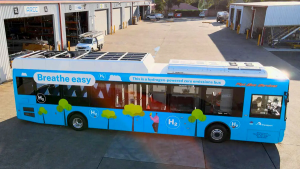Jitendra Singh, Union Minister of State for Science and Technology, presented a hydrogen fuel cell bus built by KPIT-CSIR in Pune on Wednesday. The hydrogen fuel cell generates electricity from hydrogen and air, emitting only heat and water.
Hydrogen fuel cells, such as the one on the bus, generate energy by mixing hydrogen and oxygen atoms. The two gases react across an electrochemical cell comparable to a traditional battery cell to generate electricity, water, and tiny amounts of heat. Electric motors utilize this power to drive the car forward.
Like a normal cell, a fuel cell comprises an anode (negative electrode) and a cathode (positive electrode) sandwiched around an electrolyte. According to the US Department of Energy, fuel cells function similarly to traditional batteries seen in electric cars, except they do not run out of charge and do not require power to replenish. They continue to generate energy as long as hydrogen is available.
The anode receives hydrogen, whereas the cathode receives air. A catalyst at the anode splits hydrogen molecules into protons and electrons opposite the cathode. The electrons go via an external circuit, generating an electric current that may be utilized to electric power motors. Protons, on the other hand, pass through the electrolyte to the cathode. They combine with oxygen and electrons to make water and heat once there.
Benefits of a hydrogen fuel cell vehicle
The real benefit of hydrogen fuel cell electric cars (FCEV) is that they emit no exhaust. They emitted water vapor and warm air solely. Another advantage is that they are more efficient than cars powered by internal combustion engines.
Hydrogen fuel cell electric cars offer additional benefits in refueling time, making them more feasible for public transit than battery-powered electric vehicles. Even with the most advanced charging systems, powering a battery-powered electric bus may take hours. Meanwhile, hydrogen can be recharged in a fuel cell car in minutes, almost as quickly as a conventional internal combustion engine can be refilled with fossil fuels.
While this may not be a serious issue for battery-powered personal cars, it may mean that a key asset is out of service for a significant portion of the day because it has to be charged.
Is it possible for hydrogen fuel cell automobiles to be ecologically friendly?
One important distinction is that utilizing a battery-powered electric car does not imply that the vehicles emit no pollutants but emit no tailpipe emissions. Because the bulk of the country’s power is derived from fossil fuels, and the world’s largest source of hydrogen is likewise derived from fossil fuels, the use of these cars produces a significant amount of pollution.
However, just as we are going toward renewable energy sources for electricity, we may also be moving toward renewable hydrogen generation technologies in the future. Even if these cars now contribute to emissions, the fuel they require might be provided by sustainable sources such as solar and wind energy






 French government to give €4,000 to Exchange Car for an e-bike
French government to give €4,000 to Exchange Car for an e-bike